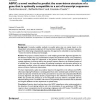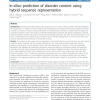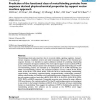1653 search results - page 13 / 331 » Adversarial Sequence Prediction |
BMCBI
2005
13 years 7 months ago
2005
Background: Currently available methods to predict splice sites are mainly based on the independent and progressive alignment of transcript data (mostly ESTs) to the genomic seque...
BMCBI
2011
12 years 11 months ago
2011
Background: Intrinsically disordered proteins play important roles in various cellular activities and their prevalence was implicated in a number of human diseases. The knowledge ...
IDEAL
2005
Springer
14 years 1 months ago
2005
Springer
Prediction of peroxisomal matrix proteins generally depends on the presence of one of two distinct motifs at the end of the amino acid sequence. PTS1 peroxisomal proteins have a we...
ICANN
2001
Springer
14 years 1 days ago
2001
Springer
This paper studies the use of discrete-time recurrent neural networks for predicting the next symbol in a sequence. The focus is on online prediction, a task much harder than the c...
BMCBI
2006
13 years 7 months ago
2006
Metal-binding proteins play important roles in structural stability, signaling, regulation, transport, immune response, metabolism control, and metal homeostasis. Because of their...



